Abstract
The aim of this study was investigation of adaptive alterations in the structure of heart rhythm regulation, the functional levels of memory, and the dynamic characteristics of behavior after the administration of glycine. The heart rhythm variability, using standard statistical techniques of autocorrelation and spectral analysis, was analyzed. Nonsymbolic testing of the visual memory in three visual pattern (7 + 2) exposure modes was also assessed, where the number of correct and incorrect responses and temporal characteristics were calculated. Assessment of the functional state was conducted using dynamic characteristics of the behavioral act in stochastic and deterministic environments and involved measurement of the total response rate, its variance, and differential characteristics of decision making given repeated choices and during choice assessment after successful and unsuccessful trials. Healthy subjects 35–45 years old (7 males and 10 females) were tested before and after sublingual administration of glycine, 0.2 g two times a day, for three weeks. It was found that the sympathetic contribution to the heart rate regulation increased after the administration of glycine and was more pronounced in females. The rate of cognitive processing also significantly increased with an increased plasticity of prognostic self-regulation in all subjects and increased the sensitivity in a stochastic environment in females.
Similar content being viewed by others
REFERENCES
Sheveleva, G.A., Filimonov, V.G., Uroshleva, L.A., et al., Correcting Properties of Glycine for Alcohol Intoxication in the Fetal Period of Pregnancy, Eksperim. Klin. Farmakol., 1996, vol. 59, p. 27.
Stern, P. and Catovic, S., Brain Glycine and Aggressive Behavior, Pharmacol. Biochem. Behav., 1975, vol. 3, no. 5, p. 723.
Kartseva, A.G., Vereskun, S.B., and Dmitrieva, A.V., Investigation of Cardio-Haemodynamic Responses Caused by Glycine Effect on Neurons of the Ventrolateral Area of the Medulla Oblongata in the Cat, Fiziol. Zh., 1988, vol. 34, no. 2, p. 40.
Kovalev, G.V., Bondarenko, A.V., Guzheva, E.P., et al., Glycine Action on Mechanisms of the Regulation of Vascular Tonus, Zh. Eksp. Klin. Med. Akad. Nauk ArmSSR, 1975, no. 3, p. 27.
Mashkovskii, M.D., Lekarstvenniye sredstva (Medicinal Drugs), Moscow, Nauka, 1993.
Baevskii, P.M., Kukushkin, Yu.A., Marasanov, A.V., et al., Methods for the Assessment of the Functional State of the Human Body, Med. Truda Prom. Ekol., 1995, no. 3, p. 30.
Kaplan, A.Ya., Dynamic Characteristics of Elementwise Reproduction of Visual Matrix Images: Phenomenology and Pharmacological Analysis, Med. Tekhnika, 1991, no. 2, p. 40.
Matveev, E.V., Nadezhdin, D.S., Zuyev, L.N., et al., Computer Instrumental Means of Psychophysiological Research of Higher Nervous Activity in Norm and Pathology, Med. Tekhnika, 1996, no. 1, p. 46.
Malik, M., Task Force of the European Society of Cardiology and the North American Society of Pacing and Electrophysiology: Heart Rate Variability Standards of Measurement, Physiological Interpretation and Clinical Use, Eur. Heart J., 1996, vol. 17, p. 354.
Khaspekova, N.B., Dyukova, G.M., Tumalaeva, Z.N., and Alieva, Kh.K., Vegetative Regulation in Patients with Panic Attacks: A Longitudinal Analysis of Heart Rate Variability, Zh. Nevrol. Psikhiatr. im. S.S. Korsakova, 1999, no. 7, p. 41.
Godovalova, L.A. and Kovalev, G.V., Effect of Glycine on Peripheral Mechanisms of Autonomic Regulation, Fiziol. Zh., 1983, vol. 29, no. 4, p. 492.
McCabe, P.M., Gengue, B.Q., Ackies, P.K., and Porges, S.W., Changes in Heart Period, Heart Period Variability, and a Spectral Analysis Estimate of Respiratory Sinus Arrhythmia in Response to Pharmacological Manipulations of the Baroreceptor Reflex in Cats, J. Psychophysiol., 1985, vol. 22, p. 145.
Richards, J.E., Heart Rate Responses and Heart Rate Rhythms, and Infant Visual Sustained Attention, Adv. Psychophysiol., 1988, vol. 3, p. 189.
Kuterman, E.M. and Khaspekova, N.B., Typological Elements of Tonic Heart Rate Components, Fiziol. Chel., 1995, vol. 21, no. 6, p. 146.
Klimakova-Cherkasova, V.I., Portova, L.Z., Sizaya, N.A., et al., Mechanisms of Individual Adaptivity to Neuropsychological Loads at Various States of the Blood Circulation System, Fiziol. Zh. im. I.M. Sechenova, 1994, vol. 80, no. 6, p. 32.
Vartanyan, G.A. and Kozlov, A.P., Electrophysiological Analysis of the Efficiency of Choice between Behavioral Programs, Fiziol. Zh. im. I.M. Sechenova, 1995, vol. 81, no. 7, p. 33.
Rusalov, V.M. and Koshman, S.A., Neurophysiological Factors of Probabilistic Learning, Fiziol. Chel., 1980, vol. 6, p. 242.
Author information
Authors and Affiliations
Rights and permissions
About this article
Cite this article
Deryagina, L.E., Ruvinova, L.G., Sidorov, P.I. et al. Adaptive Transformations of the Heart Rhythm Regulation and Structure of Behavioral Acts after Glycine Administration. Human Physiology 27, 606–609 (2001). https://doi.org/10.1023/A:1011924713938
Issue Date:
DOI: https://doi.org/10.1023/A:1011924713938




